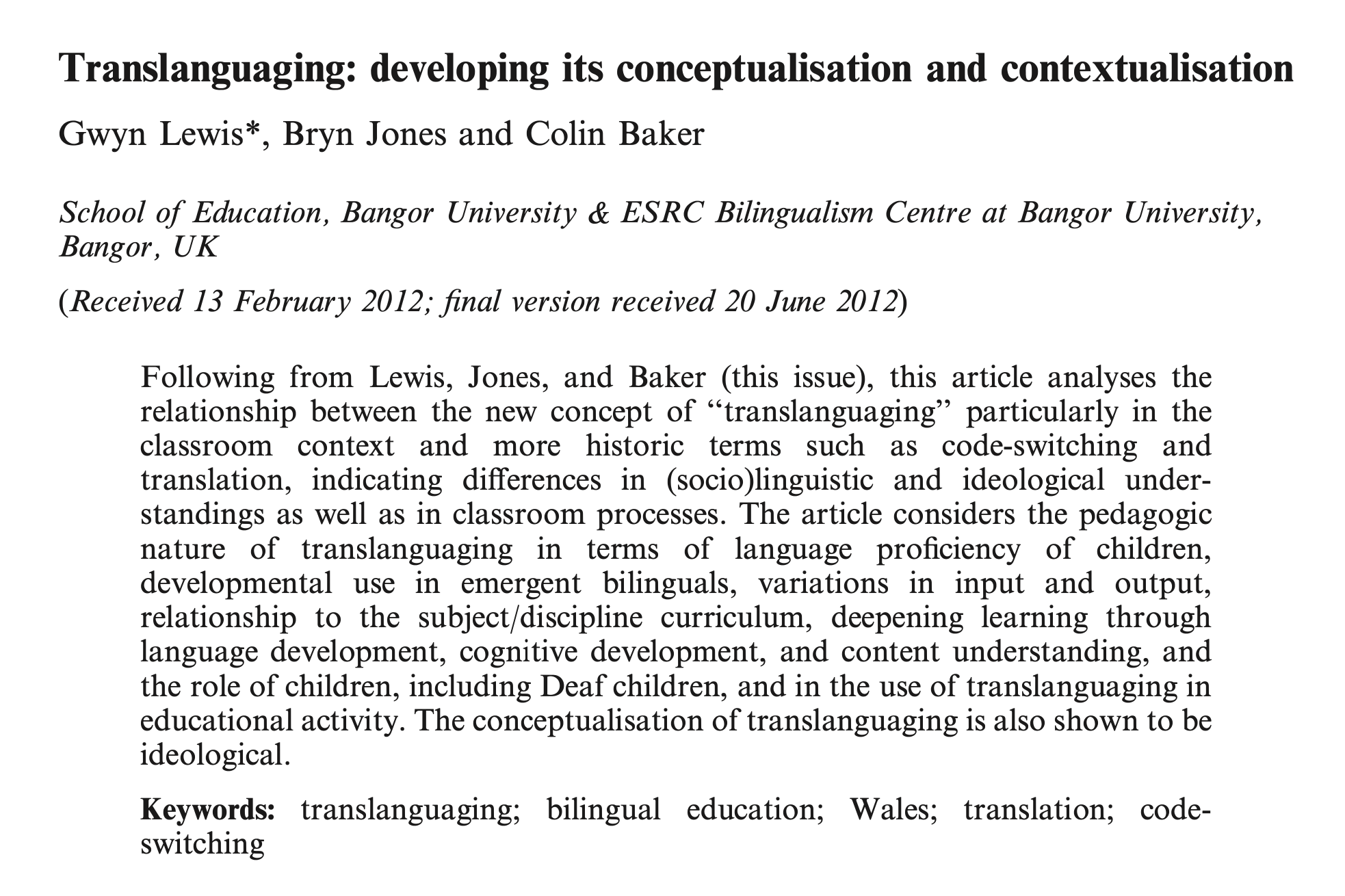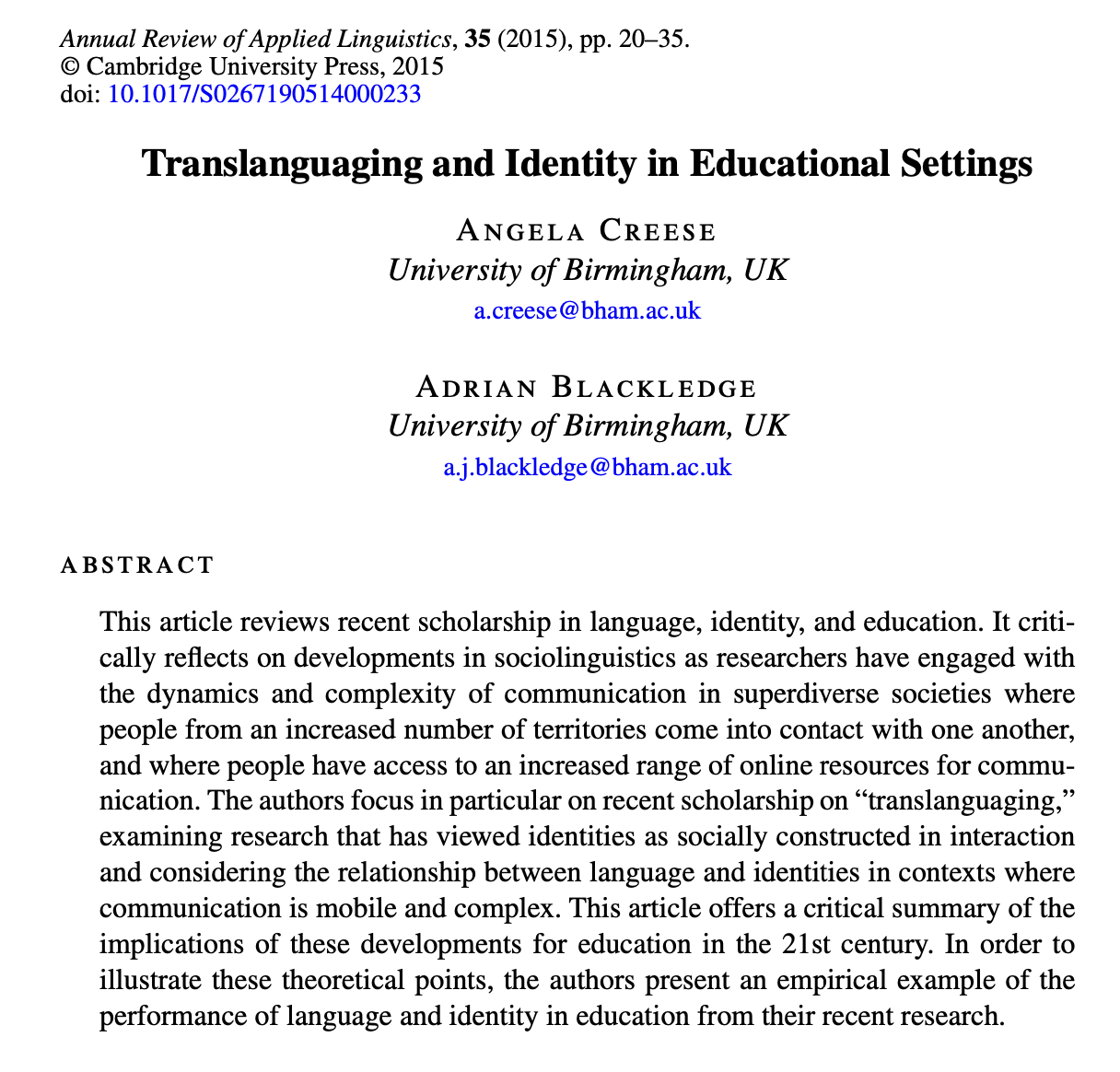Translanguaging


I’ve recently found myself reading on translanguaging as a part of my long quest to explore “how can we use LLMs to enhance education”. This blog post is about my take-aways from two papers and I’ll occasionally dump my thoughts.
[1] Translanguaging: developing its conceptualisation and contextualisation
Translanguaging is defined as “the process of making meaning, shaping experiences, gaining understanding and knowledge through the use of two languages” [1]. Although I’m using English as my main language for communication in workplace as well as in most of social encounters, I have never consciously put thought into this. In a class environment, translanguaging tries to draw on all the linguistic resources of the child to maximise understanding and achievement [1]. In some sense, it’s quite the opposite of diglossia, where the two languages of a bilingual have different uses and functions (e.g., using different languages in the classroom vs at home or for religion). Some argue that multilingual classrooms in the 21st century are moving from diglossic to transglossic arrangements (from rigid to flexible language use). For example, pupils with different linguistic profiles are involved in group work and often ignore the language use norms of the classroom, using languages flexibly to support their understandings and building conceptual and linguistic knowledge. [1]
Not just in the contemporary schools, but also in our undergraduate years I remember using both English and Turkish depending on the context. I remember these early years where thinking in Turkish using English vocabulary was simpler. As much as this changed over time, I imagine this phenomenon holding in many settings where the language of education differs from the mother tongue. Further, globalization and the use of the Internet inevitably makes resources more and more in English. Finally and most importantly, migration immediately implies language barrier in schools, which I reckon is the even worse in case of forced migration due to socio-political causes.
My own experience seems to resemble what’s called code-switching, that is, using both languages in the same “sentence” in classroom exchanges. It must be noted that “codeswitching is not simply a combination and mixture of two languages but creative strategies by the language user”. Unlike spontaneous code-switching as in my case, “responsible” code-switching is planned code-switching by the teacher to enhance the students’ cognitive skills and “to clarify or reinforce lesson material”. It is a so-called scaffolding technique, which are used to move students progressively toward stronger understanding and, ultimately, greater independence in the learning process.
Garcia argues that “the core of bilingual pedagogical strategies especially for emergent bilinguals in the beginning stages is scaffolding”: Many educators encourage emergent bilinguals to look up resources on the Web in their home languages, as students go back and forth from Web pages that are in one language or the other. In these classrooms, emergent bilinguals make frequent use of dictionaries and glossaries. Likewise, as we saw before, students frequently conduct discussions in languages other than English when reading in English. Frequently they write first in the home language, then translate the writing piece into English… Educators who understand the power of translanguaging encourage emergent bilinguals to use their home languages to think, reflect, and extend their inner speech. (Garcia & Kleifgen, 2010, p. 63). Here, an immediate interesting question would be “can we build chat bots in a way that uses multiple languages for scaffolding, ideally actively figuring out and adapting to what language to use”.
Further notes
- In Wales, classroom translanguaging from the majority language (English) to the minority language (Welsh) is much more evident than vice versa. This contrasts with translanguaging pedagogies in other countries, for example, translanguaging from Spanish to develop English in classrooms in New York City, thus “building . . . English proficiency using the home language as a scaffold”.
- Although translanguaging was evident in all age groups, the highest percentage (i.e., 50%) occurred within the 7–11 age group.
- Translanguaging was predominantly found in arts and humanities lessons rather than in the teaching of mathematics, science, and the more practical areas of the curriculum.
An anecdote
Two pupils – one from a Welsh-speaking home and one from an English-speaking home – specifically decided to create the poster and give their presentation in Welsh. When asked why they chose to translanguage, they observed that they deliberately did so ‘‘in order to avoid copying the original material from the internet word-for-word [in English] so that we could fully understand the information conveyed in the English text’’. In other words, they ‘‘processed’’ the English information by giving their presentation in Welsh.
[2] Translanguaging and identity in educational settings
Sociolinguistic study of multilingualism has moved away from a view of languages as separate, bounded entities to a view of communication in which language users employ whatever linguistic features are at their disposal to achieve their communicative aims as best they can [2]. It is now perceived that meaning-making is not confined to the use of languages as discrete, enumerable, bounded sets of linguistic resources. Rather, signs (languages) are available for meaning-making in communicative repertoires that extend across languages and varieties that have hitherto been associated with particular national, territorial, and social groups. With this, we would need to view language as a social resource without clear boundaries, which places the speaker at the heart of the interaction.
Some argue that identity discourses and practices can be described as “discursive orientations toward sets of features that are viewed as emblematic of particular identities”. Emblematic features include the way people speak, the way they text messages, the way they update their Facebook profile, the way they dress, the food they eat, the beverage they prefer, the music they listen to, the films they enjoy, the novels they read, and so on. Judgments about whether a person has (or performs) enough of the requisite emblematic templates to be accepted as, or endowed with, membership of a particular identity or group are highly nuanced, and not always negotiable. In this conception of identity, emblematic features are empirically observable and can be investigated ethnographically. Emblems of identity are not merely psychological, but are corporeal, and are performed as practice. This is true not only of the clothes we wear, the music we listen to, the sport we play, and so on. It is also true of the way in which we deploy linguistic resources.
Translanguaging further brings together different dimensions of one’s personal history, experience and environment, their attitude, beliefs and ideology, their cognitive and physical capacity, which then the agent needs to coordinate and perform meaningfully. It’s a wholistic process concerning not just two languages but pillars defining a humanbeing.
Further notes
- Languages in contact mutually influence each other, and so labeling them as separate entities is an ideological act.
- In the late modern society, identities are not imposed from above but may be negotiable within certain social setting. Identities are performed, constructed, enacted, produced, but only in interaction with others. Naturally, multilingual speakers “decide who they want to be and choose their language practices accordingly”.
- Particularly in the bilingual classroom, translanguaging as a concept tries to move acceptable practice away from language separation, and thus has ideological—even political—associations.